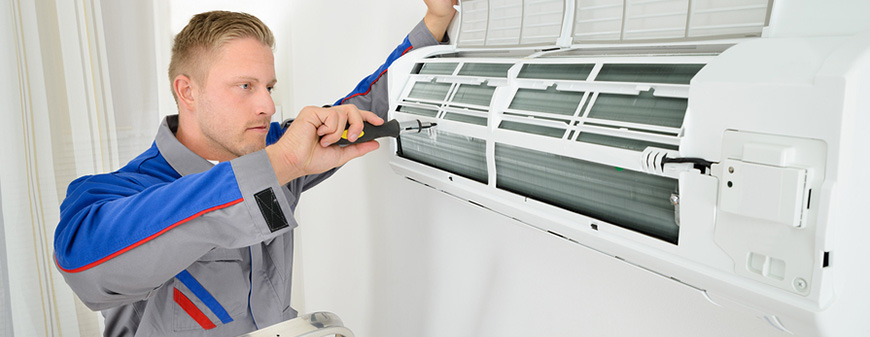
How can you keep your skills aligned with the market after HVAC school? Following innovations in HVAC equipment and changing customer preferences is one way.
Mini-split systems, also called ductless HVAC, are the equipment to watch this year. Improved efficiencies thanks to technological advancements and growing customer awareness have made them one of the fastest-growing segments of the industry.[1] Over the next 5 years, market saturation is predicted to jump from 5 percent to 15 percent.[2]
What are mini-split systems, when should they be used and what should HVAC technicians know about working in this sector of the market?
What Are Mini-Split Systems?
Mini-splits are cooling and heating systems that allow for zoning, the ability to control the temperature in specific areas of the home or individual rooms.
With a mini-split system, the evaporator is installed indoors and the compressor and condenser is installed outdoors. A conduit connects this equipment. The conduit contains copper tubing, a condensation drain line and the cables for power and communication.[3][4]
Get Started on the Path to a New Career
Fill out our form to learn how we can help you change your life.
A heat pump is typically part of systems used for heating and cooling.[5]
When to Use Mini Split Systems
There are several cases where a mini split system could be a good option:
- Mini-split systems can solve indoor-climate control problems for homes that lack ductwork, especially older houses.[6]
- Some multifamily buildings that rely on hot water, space heaters or radiant panels for heat can benefit from the addition of a ductless A/C unit.
- Even if a home or apartment building has a central air conditioner, installing additional ductwork so cooled air can reach smaller rooms or apartments may not be cost-effective.
- New, energy efficient homes where only a small space conditioning system is necessary are another good fit for mini-split systems.[7]
What HVAC Techs Need to Know about the Mini-Split Market

While more and more customers are becoming aware of mini-split systems, HVAC technicians may have to help them overcome misconceptions about the equipment. Customers may have issues with the appearance or cost of these systems.[8]
Appearance
In the past, mini-splits stood out in a room, as they were either hung on the wall or placed on the floor. This was a problem for some homeowners concerned about how their interior spaces looked.
These systems have evolved, however, and many configurations are now available. For example, there are cassettes that can be installed into the ceiling out of view and then pulled down for maintenance and repair.[9]
Features
Innovations in the mini-split market have resulted in more features for customers to choose from:
- Longer conduit lengths
- Wider ranges of operation
- Greater system capacities
- Improved efficiency levels
Mini-splits have also crossed over into the smart home HVAC market with intelligent controls.[10]
High Costs
Even though the expense of the equipment has decreased in recent years, the cost of installing it remains relatively high. Ductless systems cost nearly 30 percent more than central A/C units and about twice as much as window units of similar capacities, according to the U.S. Department of Energy.
Other expenses include:
- Control wires
- Line hides with wall inlets
- Condensate drain pipes
- Spray foam
- Proper line set evacuation
- Electrical work
The cost of labor to install mini-split systems can be higher due to all of these additional features. Companies also often spend money on training for their HVAC technicians to ensure they know how to properly install the systems.[11]
Return on Investment
One way to help customers get over the higher cost of the equipment is to discuss their potential return on investment. Two major selling points are greater efficiency and quiet operation.
“They don’t have any idea how quiet they are until they hear them running. Also, the efficiency of ductless units is out of this world. Carrier just announced a 43-SEER, 9,000-Btu unit,” said Greg Fox, the president of Fox Family Heating and Air Conditioning in California.
The greater efficiency of mini-split systems may not be the only way customers can save. Many utilities offer tax incentives and rebates to homeowners to encourage the adoption of air-source heat pumps.[12]
Education Is Key to Servicing the Mini-Split Market
The market for mini-splits is growing, which presents a business opportunity for HVAC contractors and technicians with the skills to install and service this equipment.
In addition to learning the fundamentals of refrigeration in an HVAC program, technicians might want to consider taking continuing education courses to stay abreast of this evolving segment of the industry.
Additional Sources
[1] https://www.achrnews.com/articles/137150-mini-split-heat-pumps-are-one-of-the-fastest-growing-hvac-sectors
[2] https://www.achrnews.com/articles/140289-mini-splits-continue-to-revolutionize-the-hvac-industry
[3] http://www.fujitsugeneral.com/us/residential/what-is-a-mini-split.html
[4] https://www.energy.gov/energysaver/ductless-mini-split-air-conditioners
[5] https://learn.compactappliance.com/mini-splits/
[6] https://www.achrnews.com/articles/140289-mini-splits-continue-to-revolutionize-the-hvac-industry
[7] https://www.energy.gov/energysaver/heat-pump-systems/ductless-mini-split-heat-pumps
[8] https://www.achrnews.com/articles/140289-mini-splits-continue-to-revolutionize-the-hvac-industry
[9] https://www.achrnews.com/articles/140289-mini-splits-continue-to-revolutionize-the-hvac-industry
[10] https://www.achrnews.com/articles/137150-mini-split-heat-pumps-are-one-of-the-fastest-growing-hvac-sectors
[11] https://www.achrnews.com/articles/140289-mini-splits-continue-to-revolutionize-the-hvac-industry
[12] https://www.achrnews.com/articles/137150-mini-split-heat-pumps-are-one-of-the-fastest-growing-hvac-sectors
This blog has been labeled as archived as it may no longer contain the most up-to-date data. For a list of all current blog posts, please visit our blog homepage at https://www.rsi.edu/blog/

